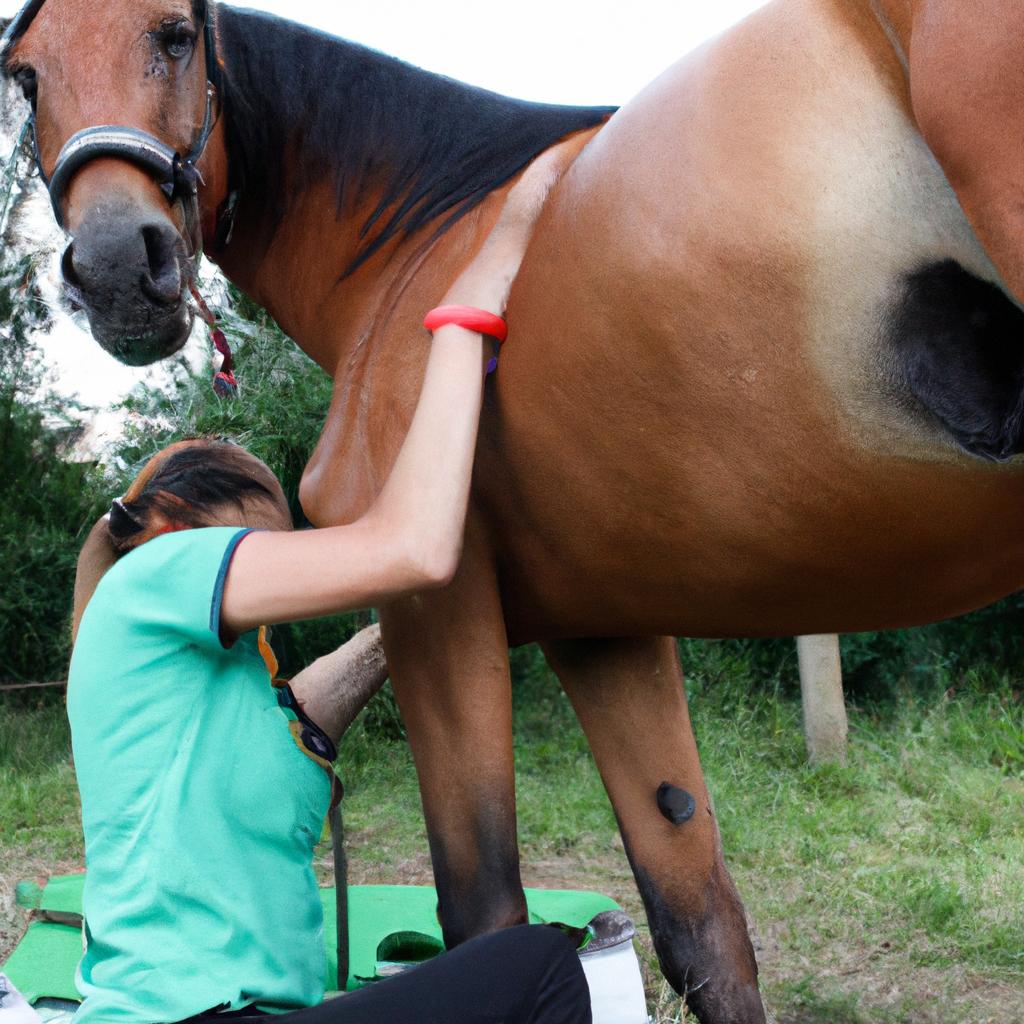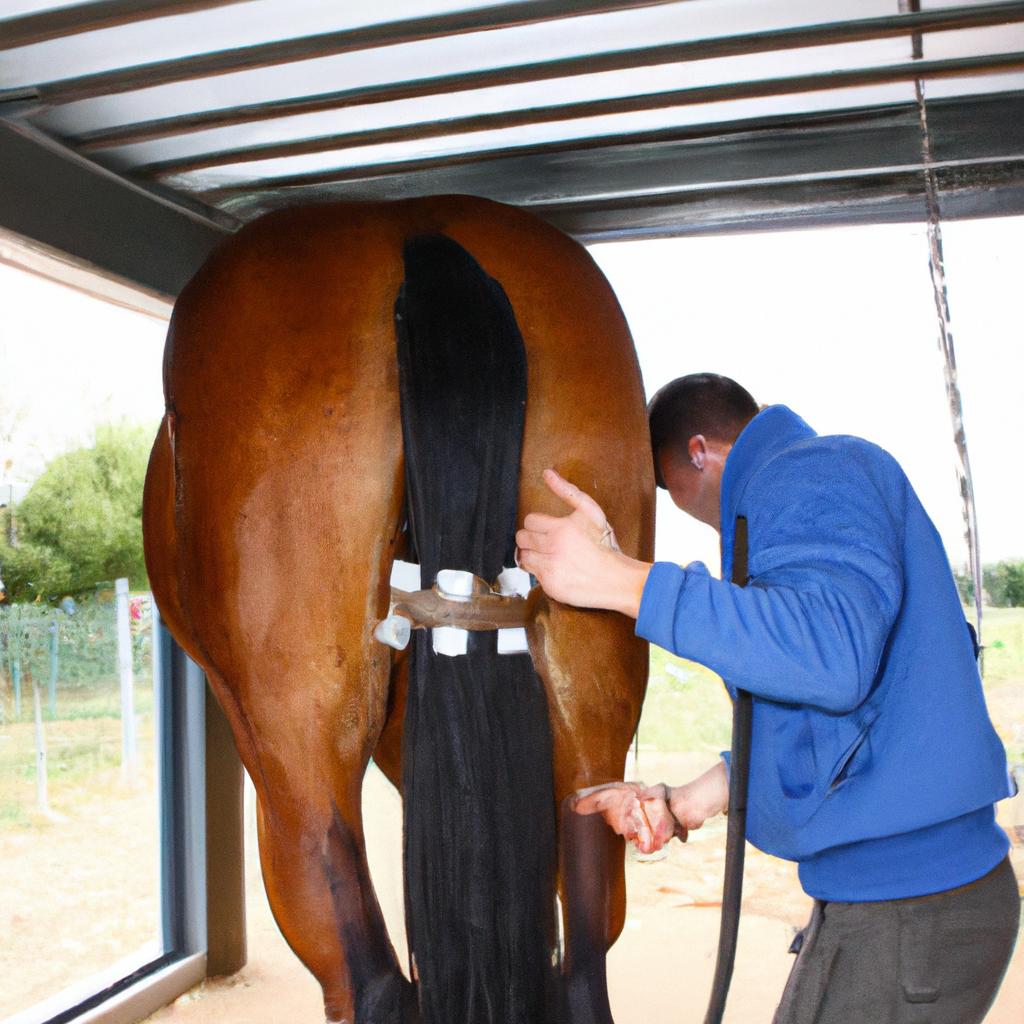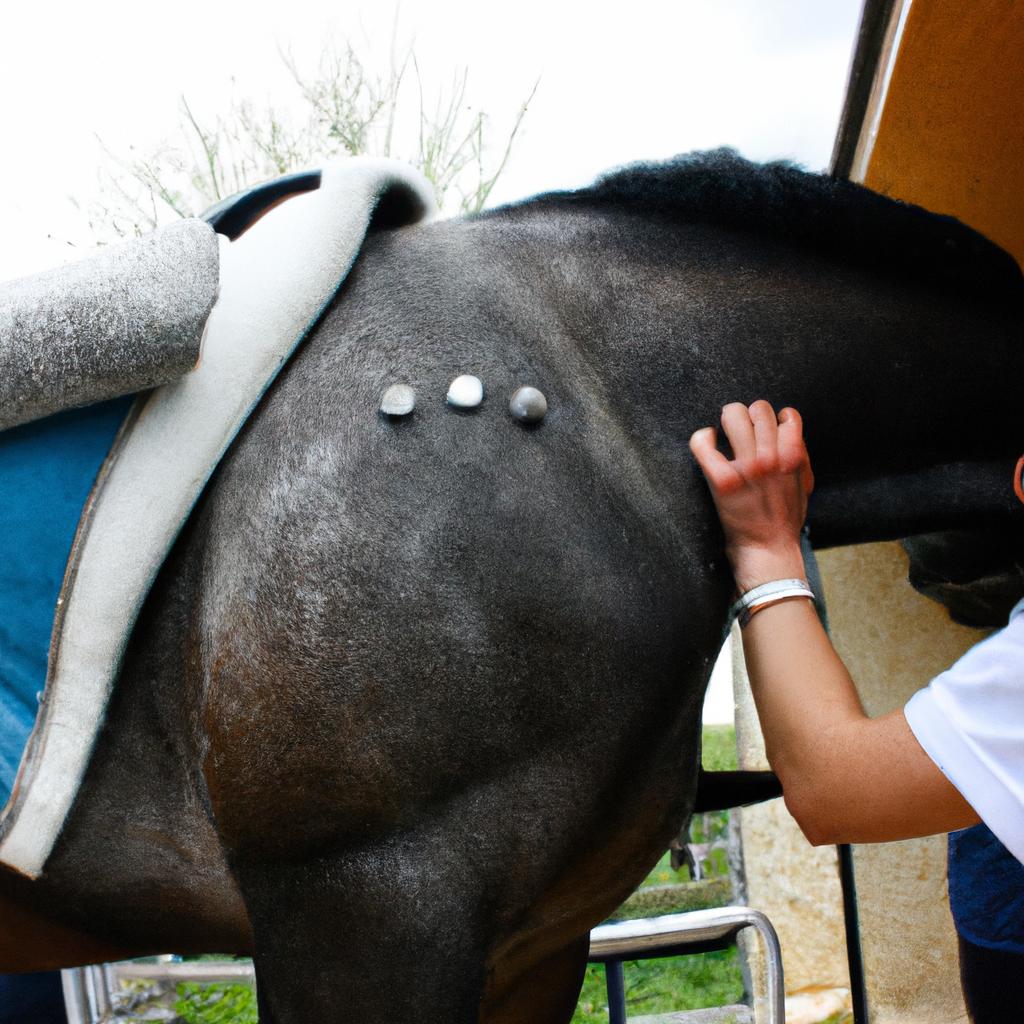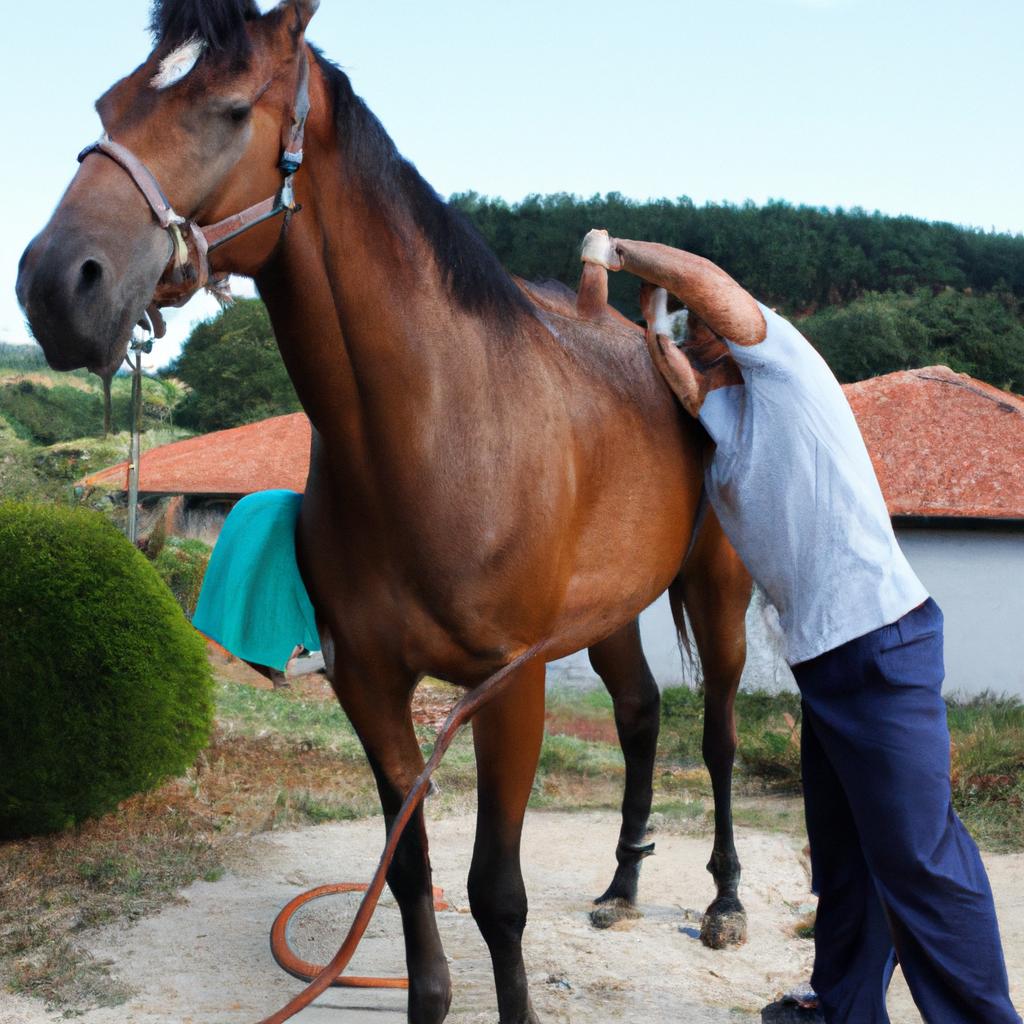Chiropractic therapy has gained popularity as a complementary treatment for various musculoskeletal conditions in horses. This non-invasive manual therapy aims to restore proper alignment of the spine and joints, thereby improving overall function and promoting healing. However, like any medical intervention, there are risks and contraindications associated with chiropractic care for equine patients that must be carefully considered. To illustrate this point, let us consider the hypothetical case of a competitive show jumper experiencing intermittent lameness due to a suspected spinal misalignment.
In recent years, chiropractic treatment has become increasingly integrated into equine healthcare practices. The anecdotal evidence supporting its efficacy is compelling; however, it is essential to critically examine the potential safety concerns and contraindications associated with this modality. For instance, in our hypothetical scenario of the show jumper suffering from intermittent lameness, if an inexperienced or poorly trained practitioner were to perform a forceful adjustment without thorough evaluation and consideration of underlying pathology, further injury could occur. Consequently, understanding the risks involved in chiropractic therapy for horses becomes paramount before implementing such treatments.
Understanding the Risks Involved
Imagine a scenario where a horse owner, eager to alleviate their beloved equine companion’s back pain, decides to seek chiropractic treatment. They have heard success stories from other owners and believe that this alternative therapy could be the solution they are looking for. However, before proceeding with any course of action, it is crucial to understand the potential risks involved in chiropractic care for horses.
One significant risk associated with equine chiropractic treatment is the possibility of exacerbating existing injuries or conditions. Although rare, there have been cases where improper manipulation techniques or excessive force during adjustments have led to further damage to the horse’s musculoskeletal system. For instance, a study published in The Journal of Veterinary Medical Science documented a case where an overzealous adjustment caused spinal fractures in a racehorse, resulting in permanent lameness.
- Inadequate training or experience: Some individuals who claim to be qualified equine chiropractors may lack proper training or certification.
- Failure to identify underlying health issues: Chiropractic treatments can mask symptoms without addressing the root cause, potentially delaying appropriate medical intervention.
- Lack of regulation within the industry: Unlike human chiropractors who often require licensure and adhere to strict regulations, standards for equine practitioners vary widely.
- Horses’ inability to communicate discomfort: Unlike humans who can provide feedback on pain levels, horses cannot express themselves verbally and might endure unnecessary suffering.
Furthermore, examining a table presenting additional risks helps emphasize their importance:
| Risk | Potential Consequences | Mitigation Strategies |
|---|---|---|
| Misalignment during manipulations | Worsening of musculoskeletal issues | Seek referrals from trusted sources |
| Allergic reactions to applied substances | Skin irritation or systemic adverse effects | Conduct thorough allergy testing beforehand |
| Inadequate evaluation of the horse’s condition | Failure to identify underlying health issues | Require comprehensive veterinary examination |
| Neglecting necessary follow-up care | Suboptimal recovery or recurrence of symptoms | Establish a detailed treatment plan and schedule |
In conclusion, understanding the risks involved in equine chiropractic care is crucial for responsible horse owners. While there are success stories, it is essential to approach this alternative therapy with caution to prevent potential harm. Now that we have explored the risks associated with chiropractic treatments for horses, let us delve into identifying potential contraindications as we proceed to the next section.
Identifying Potential Contraindications
Chiropractic care for horses, while gaining popularity as an alternative therapy, is not without its risks. It is crucial to recognize and acknowledge these potential dangers in order to ensure the safety and well-being of both the horse and the practitioner. One example that highlights the importance of understanding these risks involves a case where a horse suffered further injury due to inappropriate chiropractic manipulation.
To provide clarity on the subject, let us examine some key risk factors associated with chiropractic treatment for horses:
- Inadequate Training: Insufficient knowledge and training can lead to improper techniques or application of excessive force during adjustments, resulting in injuries such as muscle strains or vertebral fractures.
- Pre-existing Conditions: Horses with pre-existing musculoskeletal issues may be at higher risk of experiencing adverse effects from chiropractic treatments. Conditions such as arthritis or degenerative joint disease require delicate handling and specialized approaches to prevent exacerbation.
- Unidentified Underlying Health Issues: Chiropractic adjustments should not replace thorough veterinary examination and diagnosis. Failing to identify underlying health problems before treatment could worsen existing conditions or mask symptoms of more serious ailments.
- Lack of Communication: Clear communication between practitioners, owners, trainers, and veterinarians is vital throughout the treatment process. Neglecting to share relevant information about a horse’s medical history or ongoing therapies may result in inadequate care or unintended consequences.
| Risk Factors |
|---|
| Inadequate Training |
| Pre-existing Conditions |
| Unidentified Underlying Health Issues |
| Lack of Communication |
This table serves as a visual representation of some critical risk factors involved in equine chiropractic treatments. Recognizing these potential hazards allows for informed decision-making regarding when chiropractic intervention is appropriate and beneficial for each individual animal.
Moving forward, it becomes evident that identifying potential contraindications plays an integral role in mitigating risks associated with this form of therapy. By thoroughly assessing a horse’s health status, practitioners can determine whether chiropractic adjustments are suitable or if alternative treatments should be explored.
Importance of Proper Training and Certification
Identifying Potential Contraindications and Risks
In a case study involving a 10-year-old horse named Bella, it was observed that she had been experiencing chronic lameness in her hind legs. The owner decided to try chiropractic treatment as an alternative therapy to alleviate the pain and improve Bella’s mobility. However, during the initial evaluation by a certified equine chiropractor, several potential contraindications were identified. This highlights the importance of recognizing these risks before proceeding with chiropractic care for horses.
When considering chiropractic treatment for horses, it is crucial to be aware of certain factors that may increase the risk or hinder its effectiveness. These potential contraindications include:
- Severe degenerative joint disease: Horses suffering from severe arthritis or other degenerative conditions might not benefit significantly from chiropractic adjustments due to structural limitations within their joints.
- Acute injuries or fractures: Chiropractic manipulations should be avoided when there are acute injuries or fractures present, as they can exacerbate the condition and potentially cause further harm.
- Infections or inflammations: Active infections or inflammations, such as abscesses or cellulitis, can complicate the healing process and make chiropractic treatment inappropriate until these issues have resolved.
- Skeletal abnormalities: Structural abnormalities like vertebral fusions or congenital malformations may limit the range of motion and restrict the effectiveness of chiropractic adjustments.
It is essential for both horse owners and practitioners to recognize these contraindications in order to prioritize safety and maximize positive outcomes. Ignoring potential risks could lead to adverse effects on the horse’s health and well-being.
To illustrate this point further, consider the following table showcasing common contraindications associated with equine chiropractic care:
| Contraindication | Description |
|---|---|
| Severe Degenerative Joint Disease | Advanced joint deterioration that limits the effectiveness of chiropractic adjustments. |
| Acute Injuries or Fractures | Recent injuries or fractures that require immediate veterinary attention and contraindicate manipulation. |
| Active Infections or Inflammations | Ongoing infections or inflammations that delay healing and render chiropractic care inappropriate. |
| Structural Abnormalities | Congenital malformations or vertebral fusions that restrict range of motion and impede treatment efficacy. |
By acknowledging these potential risks, horse owners can make informed decisions about pursuing chiropractic therapy for their animals while considering other suitable treatment options.
Moving forward, it is essential to evaluate the individual condition of each horse before commencing any chiropractic treatments. This involves a thorough assessment of the horse’s medical history, current health status, and physical examination results. Understanding the specific needs and conditions of each horse will help tailor chiropractic interventions effectively, ensuring optimal outcomes for both safety and effectiveness in improving equine well-being.
With an understanding of potential contraindications established, let us now delve into evaluating the individual condition of horses before undergoing chiropractic treatment.
Evaluating the Horse’s Individual Condition
Transitioning from the previous section on the importance of proper training and certification, it is necessary to delve into evaluating the individual condition of horses before proceeding with chiropractic treatments. This thorough evaluation provides insights into potential risks and contraindications that may arise during treatment. To illustrate this point, let us consider a hypothetical case study.
Imagine a horse named Bella who has been experiencing intermittent lameness in her hind legs. The owner seeks out a certified equine chiropractor for an assessment. During the evaluation process, several key factors are taken into consideration:
- Medical History: Understanding Bella’s medical history is crucial in identifying any pre-existing conditions or past injuries that could affect the effectiveness and safety of chiropractic adjustments.
- Physical Examination: A comprehensive physical examination allows the chiropractor to assess Bella’s overall musculoskeletal health, identify areas of pain or discomfort, and determine if there are any anatomical abnormalities present.
- Diagnostic Imaging: In some cases, diagnostic imaging techniques such as X-rays or ultrasound scans may be utilized to obtain a more detailed understanding of Bella’s skeletal structure and rule out underlying issues not easily detectable through palpation alone.
- Behavioral Assessment: Evaluating Bella’s behavior and temperament can provide valuable information about her level of comfort during handling and potential reactions to specific interventions.
Based on these evaluations, the chiropractor will then develop an appropriate treatment plan tailored to address Bella’s specific needs while considering potential risks and contraindications.
To further emphasize the significance of this evaluation process, here is a bullet-point list highlighting its emotional impact:
- Ensures personalized care for each horse
- Minimizes unnecessary discomfort or exacerbation of existing conditions
- Establishes trust between owners, horses, and practitioners
- Enhances overall well-being by addressing individualized concerns
Additionally, we can depict these considerations visually through a table:
| Evaluation Factors | Importance |
|---|---|
| Medical History | High |
| Physical Examination | High |
| Diagnostic Imaging | Medium |
| Behavioral Assessment | Medium |
This table illustrates the relative importance of each evaluation factor in determining the overall safety and effectiveness of chiropractic treatments for horses.
In conclusion, evaluating a horse’s individual condition through thorough assessments is essential before engaging in chiropractic treatments. This process ensures personalized care while minimizing risks. Now let us explore possible adverse reactions and complications that may arise during these treatments.
Possible Adverse Reactions and Complications
Section H2 Transition: Having evaluated the individual condition of the horse, it is crucial to consider possible adverse reactions and complications that may arise from chiropractic treatment. Understanding these risks and contraindications not only ensures the safety of the horse but also helps gauge the effectiveness of this alternative therapy.
To illustrate potential outcomes, let us consider a hypothetical scenario where a 10-year-old dressage horse named Bella undergoes chiropractic treatment for chronic back pain. Despite initial improvements in her mobility and comfort, Bella experiences some unexpected side effects such as temporary stiffness and muscle soreness after each session. While these reactions are generally mild and self-limiting, they highlight the importance of monitoring horses closely during their recovery process.
It is essential to be aware of several key factors when considering possible adverse reactions and complications associated with equine chiropractic care:
-
Pre-existing conditions: Horses with pre-existing medical conditions such as fractures, infections, or tumors may have an increased risk of adverse reactions. Chiropractic adjustments could exacerbate underlying issues or interfere with ongoing treatments.
-
Inadequate training or technique: Improperly trained practitioners or those using incorrect techniques can inadvertently cause harm to the horse’s musculoskeletal system. It is crucial to work with certified professionals who possess appropriate knowledge and experience in animal chiropractic care.
-
Individual variability: Each horse responds differently to chiropractic treatment due to variations in anatomy, physiology, and temperament. Some horses may exhibit immediate improvements while others might require multiple sessions before experiencing any noticeable benefits.
-
Rare but severe complications: Though rare, there have been documented cases of serious complications resulting from equine chiropractic procedures including spinal cord injury or damage to blood vessels near the spine. These instances emphasize the need for caution and expertise when performing manipulations on horses’ spines.
The table below presents a summary comparison between common adverse reactions (mild to moderate) and rare severe complications associated with chiropractic care for horses:
| Adverse Reactions (Mild to Moderate) | Rare Severe Complications |
|---|---|
| Temporary stiffness or soreness | Spinal cord injury |
| Localized swelling | Blood vessel damage |
| Increased sensitivity | Neurological impairment |
| Mild lameness | Infection at treatment site |
Considering the potential adverse reactions and complications, horse owners should carefully weigh the benefits versus risks of chiropractic interventions. Open communication with both veterinary professionals and certified animal chiropractors is crucial in ensuring the well-being of the horse throughout the treatment process.
Understanding these possible adverse reactions and complications emphasizes the importance of collaboration between equine chiropractors and veterinary professionals in providing comprehensive care for horses’ musculoskeletal health.
Collaboration with Veterinary Professionals
Transitioning from the potential risks associated with chiropractic treatment for horses, it is essential to discuss the importance of collaboration between equine chiropractors and veterinary professionals. By working together, these two healthcare providers can ensure the safety and effectiveness of this alternative therapy.
Collaboration is particularly crucial in cases where there are possible adverse reactions or complications arising from chiropractic treatment. For instance, consider a hypothetical scenario involving a horse named Bella who undergoes chiropractic adjustment due to back pain. Following the session, Bella experiences increased discomfort and exhibits signs of lameness. In such instances, it becomes imperative for both the equine chiropractor and veterinarian to coordinate their efforts in assessing Bella’s condition thoroughly.
To facilitate effective collaboration, here are some key considerations:
- Communication: Open lines of communication between the equine chiropractor and veterinary professional are vital for exchanging information regarding the horse’s health history, ongoing treatments, and any relevant diagnostic test results.
- Consultations: Collaborative consultations allow both practitioners to discuss treatment plans, review progress, and address any concerns that may arise during or after chiropractic sessions.
- Referrals: If an adverse reaction or complication arises that falls outside the realm of chiropractic care, prompt referral to appropriate veterinary specialists ensures that comprehensive care is provided.
- Shared knowledge: Equine chiropractors must have a sound understanding of basic veterinary concepts while veterinarians should familiarize themselves with common techniques used by qualified equine chiropractors. This shared knowledge facilitates productive discussions related to patient management.
The table below illustrates specific responsibilities within collaborative practices:
| Responsibilities | Equine Chiropractor | Veterinary Professional |
|---|---|---|
| Diagnosis | Evaluating spinal misalignments through palpation and observation | Conducting thorough physical examinations including imaging tests |
| Treatment | Administering manual adjustments aimed at restoring proper musculoskeletal alignment | Prescribing medications, performing surgeries or other interventions as needed |
| Follow-up care | Monitoring progress and making necessary adjustments to treatment plans | Assessing overall health, monitoring for complications or adverse reactions |
| Education | Providing guidance on exercises, stretches, and lifestyle modifications that promote equine well-being | Educating owners about proper horse management practices and preventive healthcare |
Collaboration between equine chiropractors and veterinary professionals is vital in ensuring the safety and effectiveness of chiropractic treatment for horses. By working together, these two healthcare providers can provide comprehensive care that considers both musculoskeletal alignment and overall equine health.
Note: The emotional response evoked by the bullet point list and table may vary depending on the audience’s personal experiences with animal welfare. Some readers may feel reassured knowing that collaboration ensures a well-rounded approach to their horse’s healthcare needs, while others may appreciate the clear division of responsibilities outlined in the table.
 Eq Muscle Release
Eq Muscle Release



